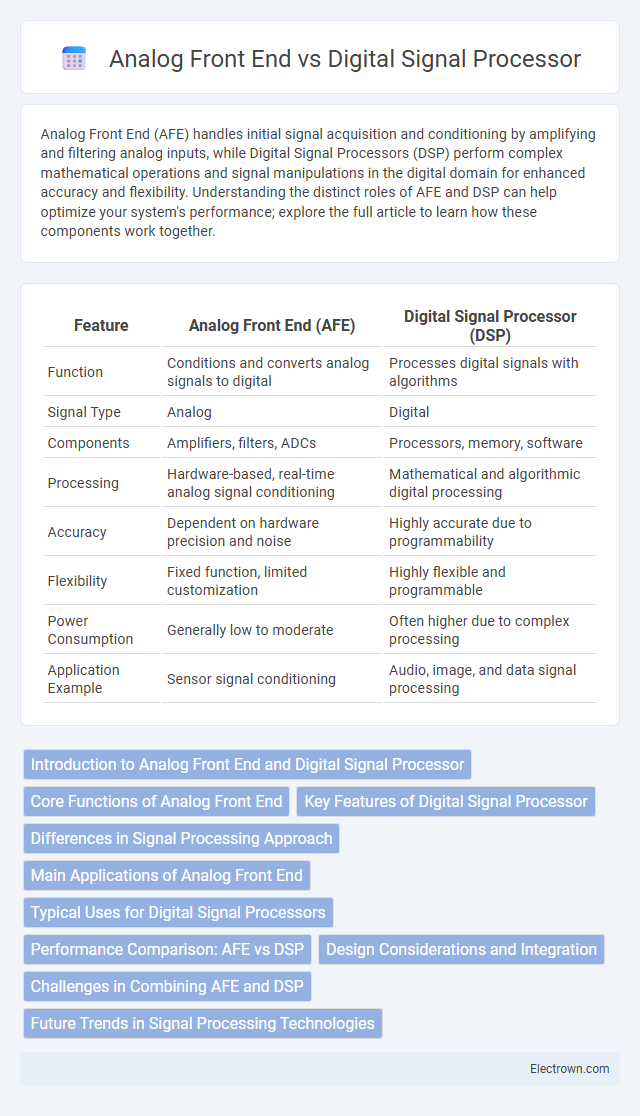Analog Front End (AFE) handles initial signal acquisition and conditioning by amplifying and filtering analog inputs, while Digital Signal Processors (DSP) perform complex mathematical operations and signal manipulations in the digital domain for enhanced accuracy and flexibility. Understanding the distinct roles of AFE and DSP can help optimize your system's performance; explore the full article to learn how these components work together.
Table of Comparison
| Feature | Analog Front End (AFE) | Digital Signal Processor (DSP) |
|---|---|---|
| Function | Conditions and converts analog signals to digital | Processes digital signals with algorithms |
| Signal Type | Analog | Digital |
| Components | Amplifiers, filters, ADCs | Processors, memory, software |
| Processing | Hardware-based, real-time analog signal conditioning | Mathematical and algorithmic digital processing |
| Accuracy | Dependent on hardware precision and noise | Highly accurate due to programmability |
| Flexibility | Fixed function, limited customization | Highly flexible and programmable |
| Power Consumption | Generally low to moderate | Often higher due to complex processing |
| Application Example | Sensor signal conditioning | Audio, image, and data signal processing |
Introduction to Analog Front End and Digital Signal Processor
Analog Front End (AFE) is a crucial hardware component that interfaces with real-world sensors, converting analog signals into digital data through amplification and filtering processes. Digital Signal Processor (DSP) is specialized microprocessor technology optimized for high-speed numeric calculations and real-time signal processing tasks, enhancing data analysis and communication. Your system's performance depends on the efficient integration of AFE for accurate signal capture and DSP for advanced data manipulation and control.
Core Functions of Analog Front End
The core functions of an Analog Front End (AFE) include signal conditioning, filtering, amplification, and analog-to-digital conversion, which prepare raw analog signals for further digital processing. AFEs are critical for minimizing noise and distortion while optimizing signal integrity before the data reaches the Digital Signal Processor (DSP). These functions enable accurate representation of physical phenomena such as temperature, pressure, or biometric signals in digital systems.
Key Features of Digital Signal Processor
Digital Signal Processors (DSPs) feature specialized arithmetic units optimized for real-time signal processing, including fast multiply-accumulate (MAC) operations essential for filtering and Fourier transforms. They support parallel processing architectures and instruction sets designed for high-speed data throughput and low latency, enabling efficient audio, video, and communication applications. Your choice of DSP ensures enhanced precision and adaptability compared to Analog Front End components, which primarily handle signal conditioning before conversion.
Differences in Signal Processing Approach
Analog Front End (AFE) processes signals in continuous analog form, capturing real-world data through amplification, filtering, and conversion before any digital manipulation. Digital Signal Processors (DSP) handle signals after analog-to-digital conversion, performing complex algorithms, filtering, and transformations in discrete, numerical formats for precision and flexibility. Your choice depends on whether you need real-time analog interfacing with sensors (AFE) or advanced signal manipulation and analysis (DSP).
Main Applications of Analog Front End
Analog Front End (AFE) is primarily used in applications requiring precise sensor signal conditioning, such as medical devices, industrial automation, and communication systems. It interfaces directly with analog sensors, amplifying, filtering, and converting signals to prepare them for digital processing within Digital Signal Processors (DSP). Your choice of AFE influences the accuracy and efficiency of measurements in critical environments like wearable health monitors and wireless sensor networks.
Typical Uses for Digital Signal Processors
Digital Signal Processors (DSPs) are specialized microprocessors designed for high-speed numeric calculations essential in audio, image, and speech processing applications. Typical uses for DSPs include real-time signal filtering, voice recognition systems, and digital image enhancement, where precise, rapid data manipulation is crucial. Your choice of DSP can significantly impact the efficiency and performance of embedded systems in telecommunications, medical devices, and multimedia equipment.
Performance Comparison: AFE vs DSP
Analog Front End (AFE) excels in real-time signal conditioning with minimal latency, directly converting physical signals into usable data, making it indispensable for high-speed, low-noise applications. Digital Signal Processors (DSP) offer superior flexibility and advanced algorithmic processing capabilities, enabling complex filtering, modulation, and error correction with greater precision. Your choice depends on whether immediate analog performance or versatile digital manipulation is critical for your system's performance goals.
Design Considerations and Integration
Analog Front End (AFE) design requires precise handling of low-level signals with attention to noise, linearity, and power consumption to ensure accurate conversion before digital processing. Digital Signal Processor (DSP) integration focuses on computational efficiency, latency, and algorithmic flexibility for robust signal analysis and manipulation after analog-to-digital conversion. Optimizing system performance involves careful co-design of AFE hardware with DSP firmware to maintain signal integrity and meet real-time processing requirements.
Challenges in Combining AFE and DSP
Integrating Analog Front End (AFE) and Digital Signal Processor (DSP) components presents challenges such as signal integrity issues caused by noise and interference during analog-to-digital conversion. Synchronizing timing between the AFE's sampling processes and the DSP's computational cycles demands precise clock management to prevent data loss or distortion. Furthermore, power consumption optimization becomes complex as high-speed DSP algorithms require low-latency, high-precision data from the AFE without compromising energy efficiency.
Future Trends in Signal Processing Technologies
Future trends in signal processing technologies emphasize the integration of Analog Front End (AFE) components with advanced Digital Signal Processors (DSPs) to enhance real-time data acquisition and processing accuracy. Emerging developments include the use of machine learning algorithms embedded in DSPs for adaptive signal filtering and noise reduction, combined with low-power, high-resolution AFEs to support IoT and wearable devices. The convergence of AI-driven DSP capabilities with flexible analog interfaces is driving innovations in 5G communications, autonomous systems, and medical diagnostics.
Analog Front End vs Digital Signal Processor Infographic

 electrown.com
electrown.com